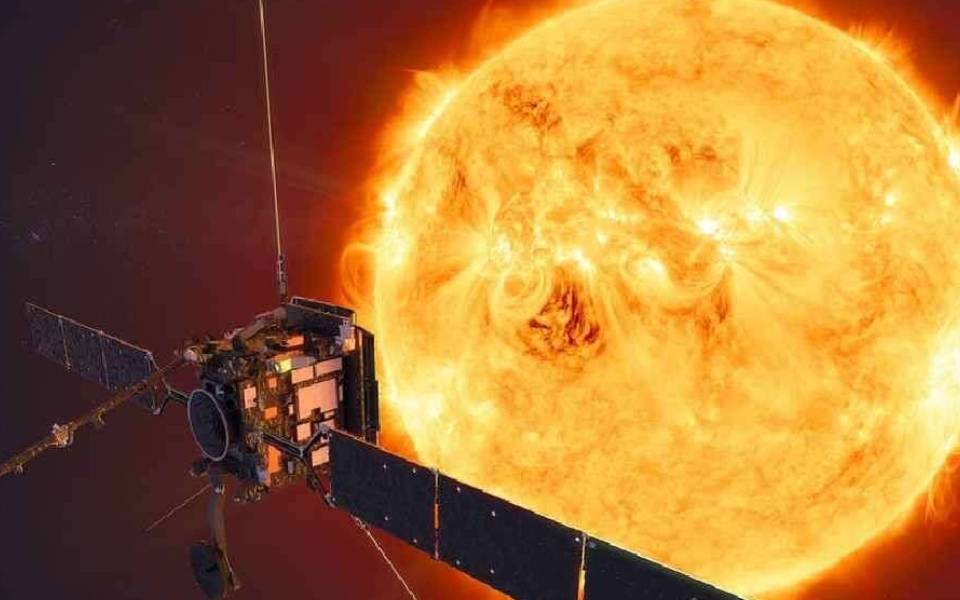Bengaluru, Nov 7: ISRO's maiden solar mission, Aditya L1, has captured its first high energy X-ray glimpse of solar flares.
During its first observation period from approximately October 29, the High Energy L1 Orbiting X-ray Spectrometer (HEL1OS) on board Aditya-L1 spacecraft has recorded the impulsive phase of solar flares, the space agency said in a statement on Tuesday.
A solar flare is a sudden brightening of solar atmosphere.
The recorded data is consistent with the X-ray light curves provided by National Oceanic and Atmospheric Administration's (NOAA) Geostationary Operational Environmental Satellites (GOES).
"Commissioned on October 27, 2023, HEL1OS is currently undergoing fine-tuning of thresholds and calibration operations. The instrument is set to monitor the Sun's high-energy X-ray activity with fast timing and high-resolution spectra," it said.
HEL1OS data enables researchers to study explosive energy release and electron acceleration during impulsive phases of solar flares.
HEL1OS was developed by the Space Astronomy Group of the U R Rao Satellite Centre, ISRO, Bengaluru, the agency added.
HEL1OS, the hard X-ray spectrometer on Aditya-L1 Solar Mission by ISRO, is the harbinger of flaring activities on the Sun, with the ability to capture the early impulsive phase of the solar activity.
According to ISRO, flares produce enhanced emission in all wavelengths across the electromagnetic spectrum radio, optical, UV, soft X-rays, hard X-rays and gamma-rays. Flare emission consists of emissions from accelerated particles and hot plasma.
Aditya-L1 spacecraft is designed for providing remote observations of the solar corona and in-situ observations of the solar wind at L1 (Sun-Earth Lagrangian point), which is about 1.5 million kilometres from the Earth.
It is the first dedicated Indian space mission for observations of the Sun. Aimed at studying the Sun from an orbit around the L1, the mission carries seven payloads to observe the photosphere, chromosphere and the outermost layers of the Sun, the corona, in different wavebands.
Aditya-L1 is a fully indigenous effort with the participation of national institutions.
An ISRO scientist told PTI that capturing the first High-Energy X-ray glimpse of Solar Flares is an indication that the mission is so far doing well on the expected lines.
Aditya-L1 Mission:
— ISRO (@isro) November 7, 2023
HEL1OS captures first High-Energy X-ray glimpse of Solar Flares
🔸During its first observation period from approximately 12:00 to 22:00 UT on October 29, 2023, the High Energy L1 Orbiting X-ray Spectrometer (HEL1OS) on board Aditya-L1 has recorded the… pic.twitter.com/X6R9zhdwM5
Let the Truth be known. If you read VB and like VB, please be a VB Supporter and Help us deliver the Truth to one and all.
Report: Thufail Muhammad Abudhabi
Dubai: The funeral of four young brothers who died in a tragic road accident near Abu Dhabi drew hundreds of mourners to the Al Qusais cemetery on Tuesday evening, leaving the UAE’s expatriate community in deep shock and grief.
The children Ashaj (14), Ammar (12), Azaam (8) and Ayyash (5) were the sons of Abdul Latheef and Ruksana, natives of Kerala’s Malappuram district. The family was returning to their Dubai residence after attending the Liwa Festival on the outskirts of Abu Dhabi when their car met with a fatal accident early Sunday morning.
Three of the children died on the spot, while Azaam succumbed to his injuries on Monday evening during treatment. The family’s domestic helper, Bushra Fayaz (49), also lost her life in the crash. Her body was repatriated to India on Monday night, and funeral rites were held in Kerala on Tuesday.
Abdul Latheef, who sustained injuries in the accident, arrived at the cemetery from Abu Dhabi in a wheelchair, his hand in a sling, to attend the burial of his sons. Mourners described the scene as one of the most heartbreaking they had ever witnessed.
“I have never seen the mass burial of children from the same family. It was devastating for everyone present,” said a social worker who assisted the family.
The couple’s only daughter, Izza (10), survived the accident with minor injuries and is undergoing treatment. Unaware of the loss of her brothers, she was seen playing on a mobile phone from her hospital bed.
Relatives said informing the parents about the tragedy was handled with extreme care. Abdul Latheef was told late on Sunday night, while Ruksana who had undergone surgery for an injury to her hand was informed only on Tuesday after counsellors were brought in to break the news professionally.
Before the burial, the parents were allowed to see their children one last time. Ruksana was taken by ambulance to the mortuary, while Abdul Latheef obtained special permission for temporary discharge from hospital to attend the funeral. Ruksana remained hospitalised with her daughter.
Though the family holds Ras Al Khaimah visas, special permission was obtained to conduct the burial in Dubai, where the family resides and where most relatives are based. Community members expressed gratitude to the Dubai authorities for facilitating the process.
Abdul Latheef runs a business in Ras Al Khaimah, while Ruksana works as a property consultant in Dubai. All five children were students of Arab Unity School in Dubai, following the British curriculum. The school management issued a circular to parents outlining measures to support students and families affected by the tragedy and advising on how to discuss the loss sensitively with children.
The cause of the accident has not yet been officially confirmed by Abu Dhabi Police. Public discussions have pointed to possible factors such as dense winter fog and overspeeding, though authorities are yet to release findings.





